Is 8GB of VRAM enough for gaming? GeForce RTX 5060 Ti 8GB vs RTX 5060 Ti 16GB GPU face-off — how much difference does twice the memory make for the same chip?
How much VRAM do you really need?
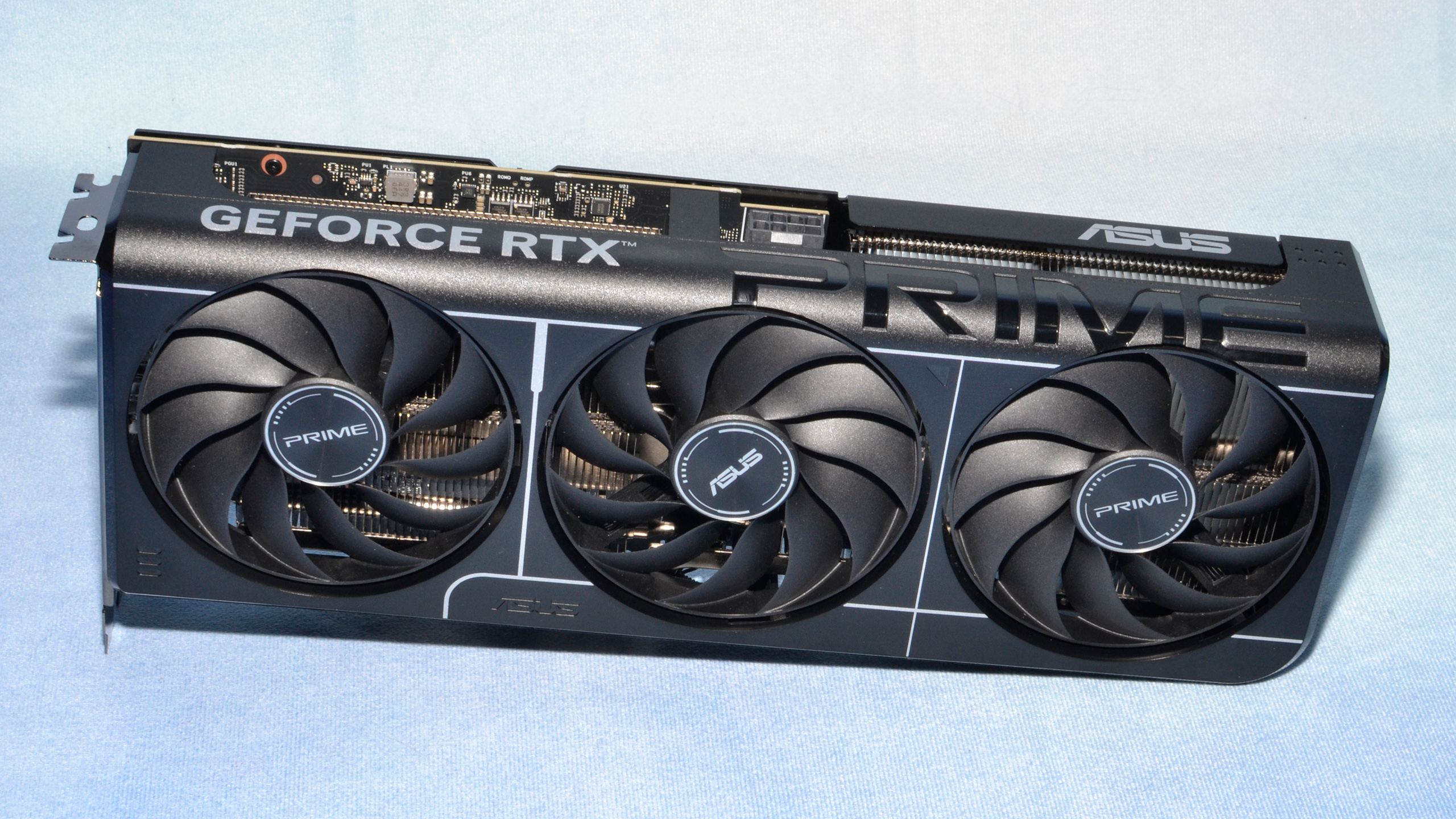
The GeForce RTX 5060 Ti enraged enthusiasts when Nvidia announced the GPU would once again offer an 8GB VRAM capacity as the baseline option. The RTX 5060 Ti represents the fifth generation of consumer Nvidia graphics cards that have featured an 8GB capacity on at least one model. The first mainstream GeForce cards featuring 8GB of VRAM were the GTX 1080 and GTX 1070, released all the way back in 2016.
8GB was a potent memory spec through the late 2010s, offering ample room to run the latest AAA games at maximum settings. Back then, AAA games like Battlefield V could even get by on 2GB GPUs at minimum specs. (The game's recommended GPU was the GTX 1060 6GB.)
Fast forward to today, and 8GB is showing its limits to the point where many of the latest AAA games cannot run on those cards at 1080p and maximum settings without suffering performance issues, especially with ray tracing or AI-powered features like framegen switched on. That's led many enthusiasts to call for Nvidia to ditch 8GB VRAM specs altogether, even on lower-end GPUs.
In this face-off, we'll be diving into the data and pitting the 8GB GeForce RTX 5060 Ti against its 16GB counterpart to see how problematic (or non-problematic) 8GB of VRAM can be in 2025, and where those problems specifically arise.
Gaming Performance
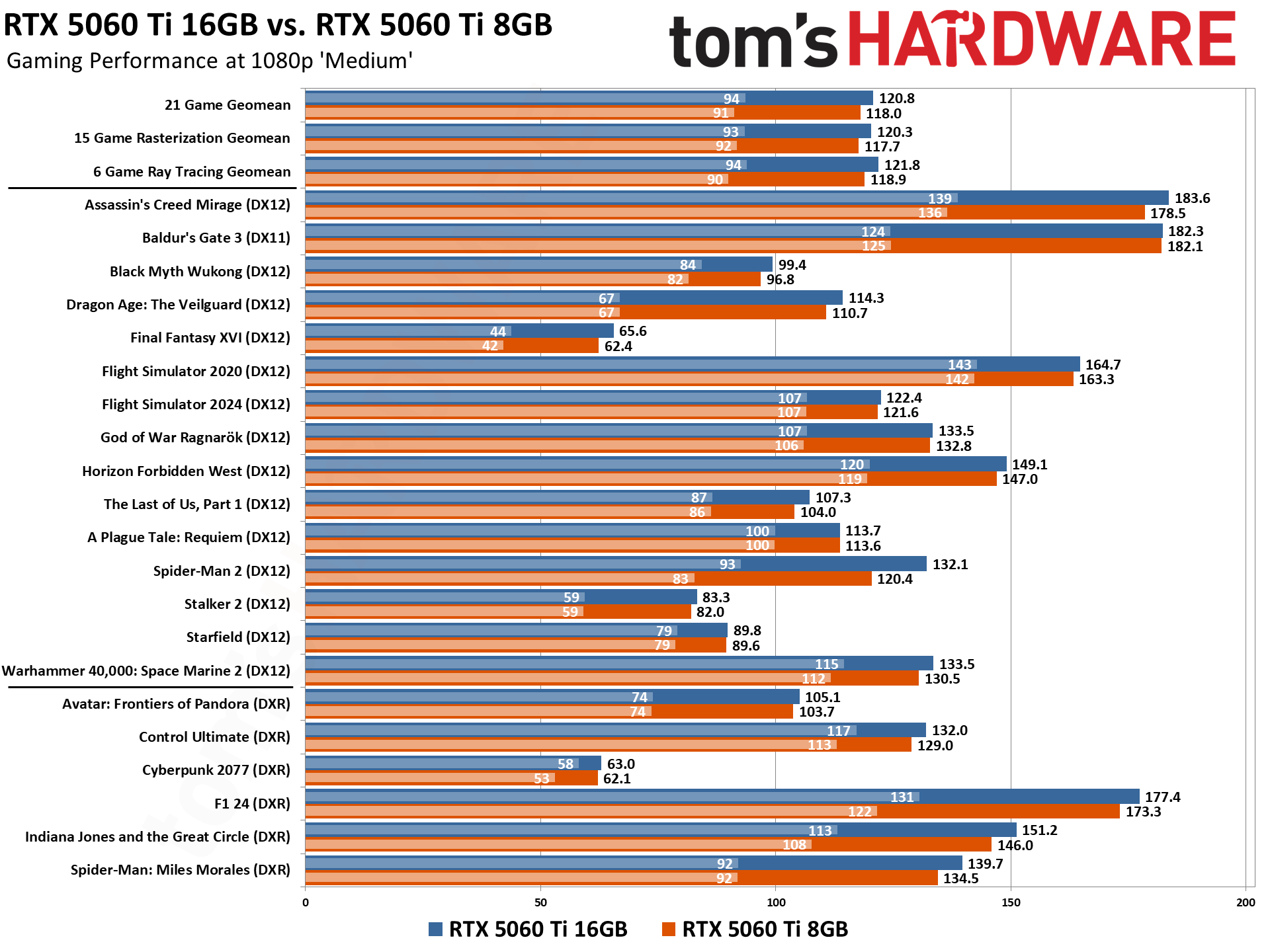

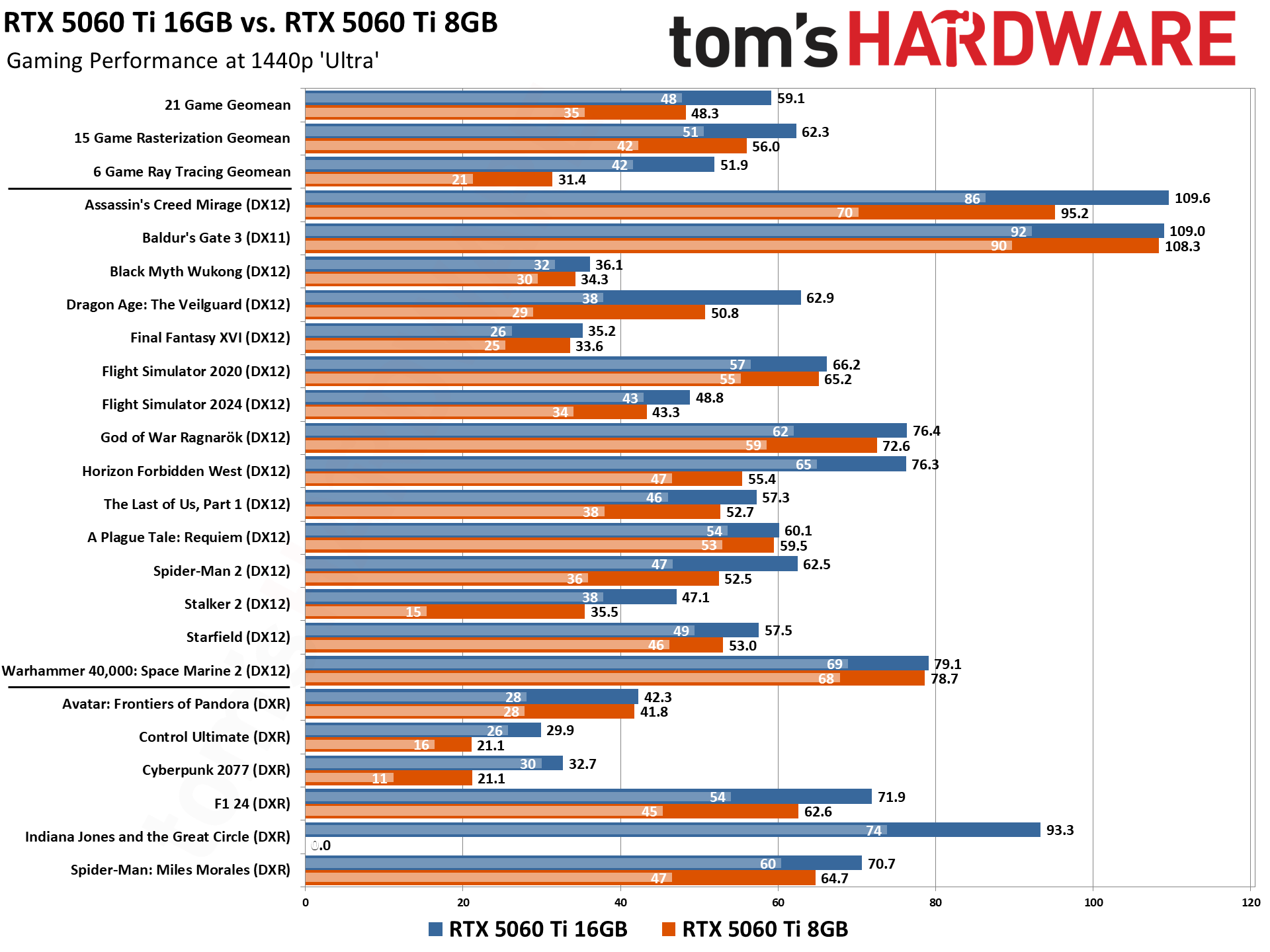
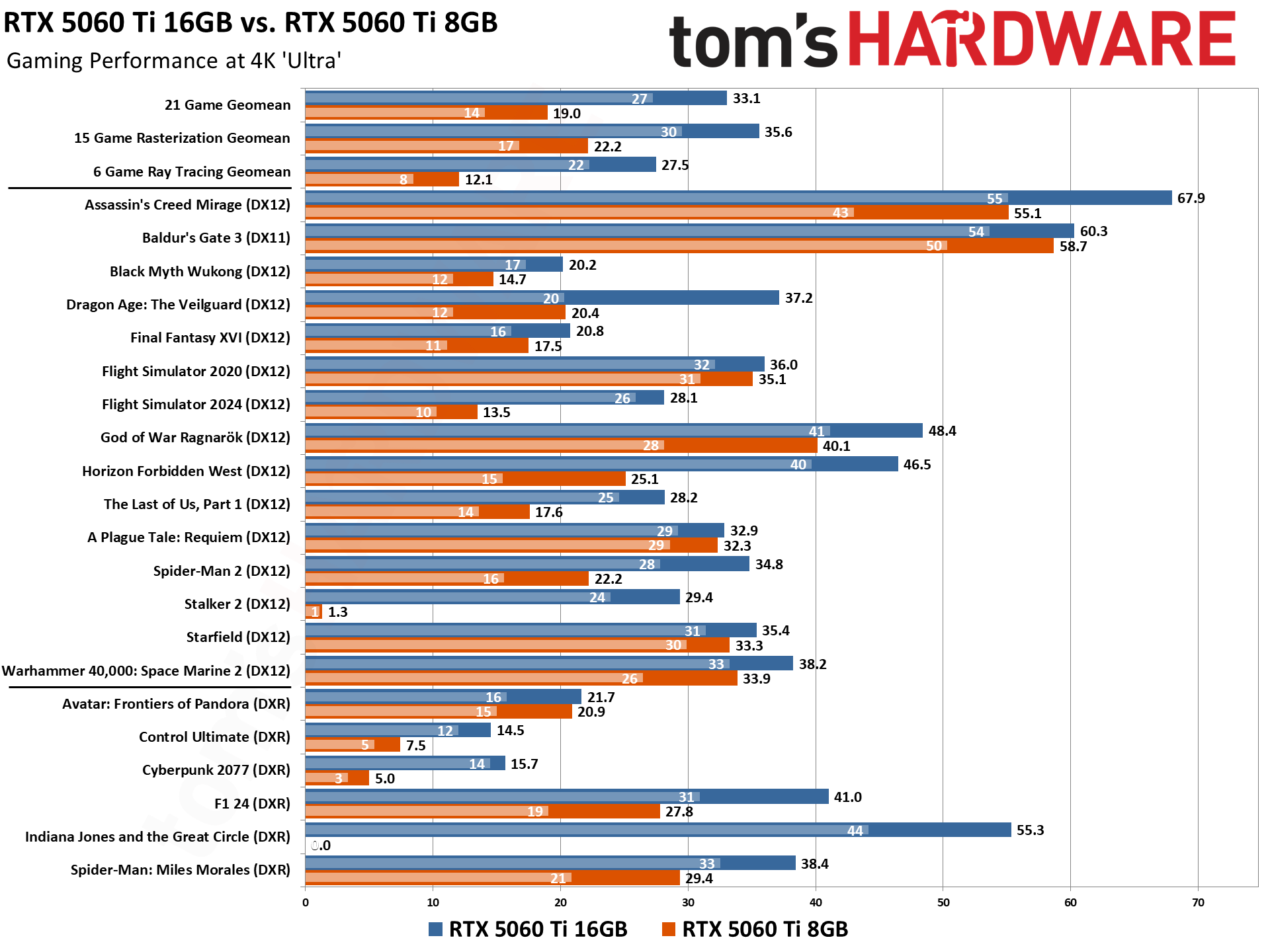
Gaming performance can vary significantly between the 8GB and 16GB versions of the RTX 5060 Ti, depending on graphics settings and resolution used. Our benchmarks reveal that the 8GB model is still sufficient for delivering a good 1080p gaming experience at medium quality settings. However, bumping up quality settings to 1080p and 1440p ultra is when the 8GB card starts to fall behind its 16GB counterpart, especially in ray-tracing titles. At 4K, the 16GB model provides unquestionably superior performance.
Our 21-game geomean reveals that the RTX 5060 8GB provides virtually identical performance compared to its 16GB counterpart at 1080p medium settings, being on average just 2.3% slower than the 16GB card. Our six-game DXR and 15-game rasterization only geomeans at the same settings demonstrate the same behavior.
1080p ultra settings showcase a noteworthy divide in performance with the 8GB model. Our 21 game geomean at 1080p ultra reveals an 11% performance disadvantage with the 8GB trim. That delta primarily comes from our ray tracing titles, which are exceptionally sensitive to having just 8GB of VRAM. Our 6-game RT geomean reveals a 26% performance drop-off for the 8GB card vs the 16GB card at 1080p ultra settings. In contrast, the RTX 5060 Ti 8GB is only 5% slower in rasterization-only games (according to our 15-game rasterization-only geomean).
Get Tom's Hardware's best news and in-depth reviews, straight to your inbox.
The RTX 5060 Ti 8GB performs notably worse at 1440p ultra across the board. The 8GB card was 18% worse on average compared to the 16GB card, but that average conceals a whopping 39.6% deficit in ray-tracing titles. It was only 10% worse in raster-only games.
4K ultra was a bloodbath for the RTX 5060 8GB, which was 42% slower than its 16GB counterpart on average across all our titles (including raster and ray tracing titles).
Some of the worst offenders were Stalker 2 and Indiana Jones and the Great Circle. The former was 24.7% slower on the 8GB card at 1440p ultra settings, and was completely unplayable in the latter, running at just 1.3 FPS at 4k ultra settings. Indiana Jones was even worse and would not run beyond 1080p medium settings on the 8GB GPU at all. The 16GB GPU, by contrast, was able to run Indiana Jones all the way up to 4K.
Another worthy mention is Spider-Man 2, which was one of the most VRAM-intensive games at 1080p. At 1080p Very High settings, the RTX 5080 8GB ran 16.9% slower than its 16GB counterpart.
⭐ Winner: RTX 5060 Ti 16GB
The RTX 5060 Ti 8GB can offer comparable performance to the 16GB in our gaming test suite, but only at 1080p medium settings. Everywhere else, the 16GB model has the edge.
Professional Workloads: Rendering, ProViz, AI
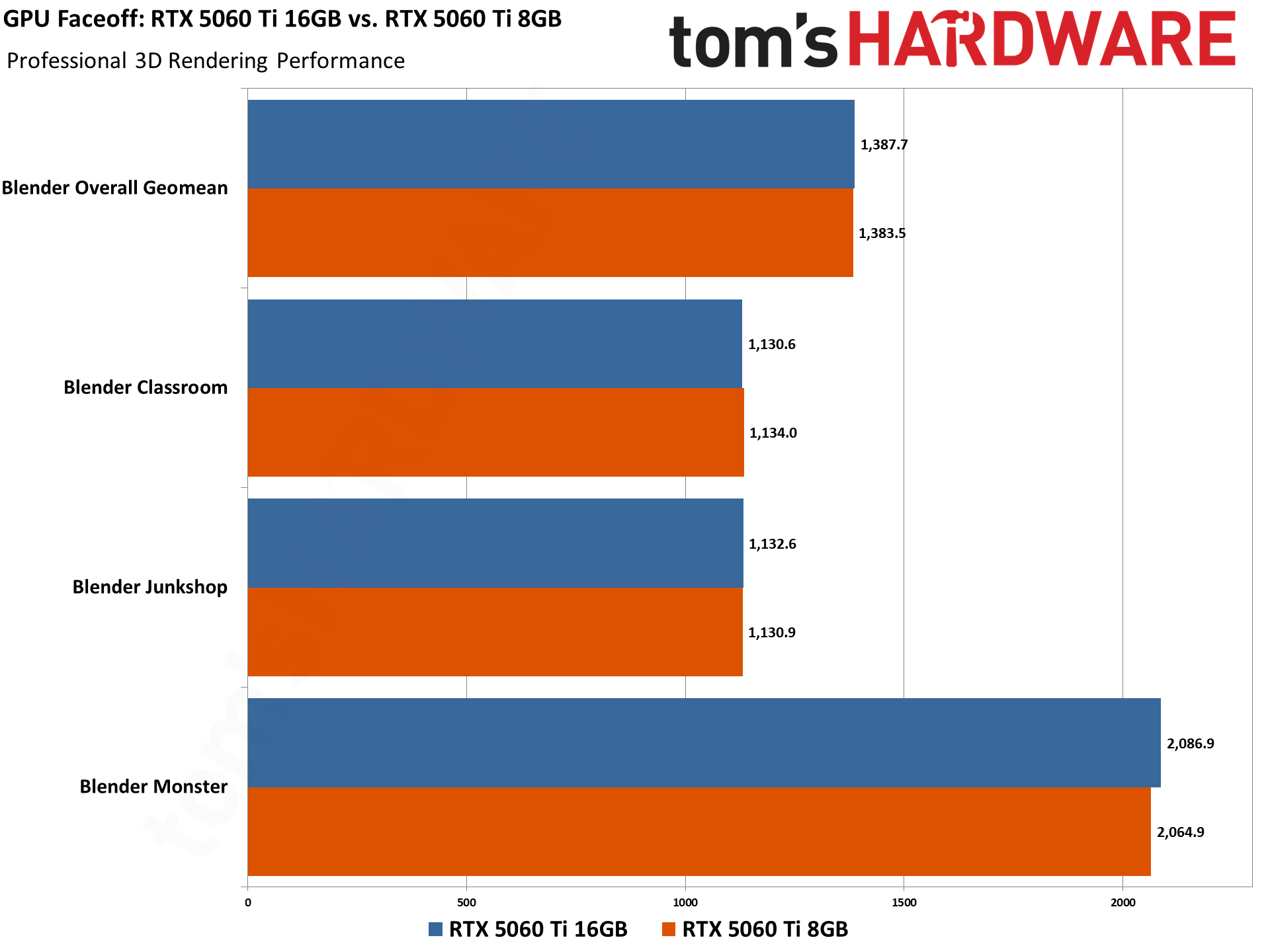
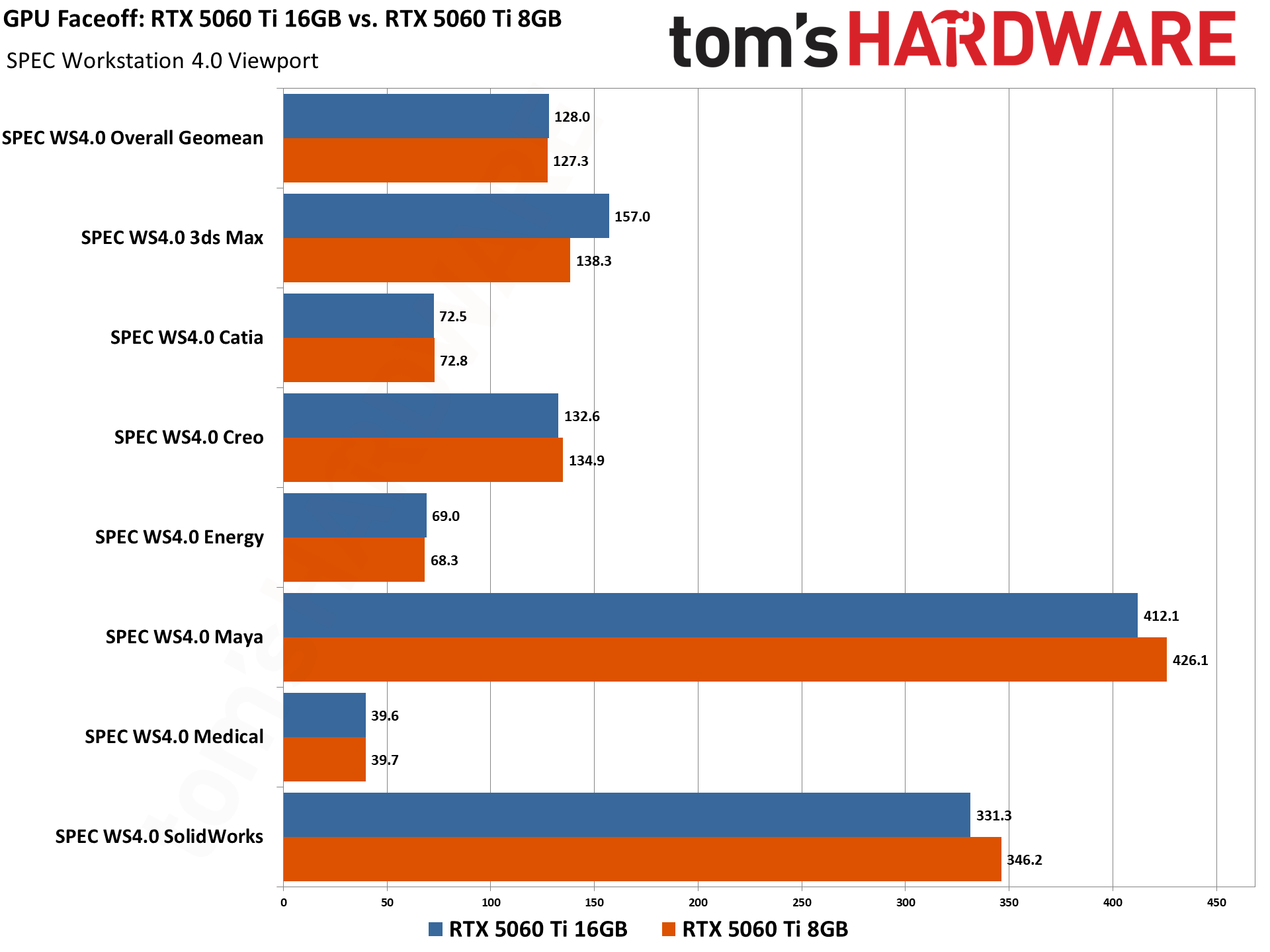
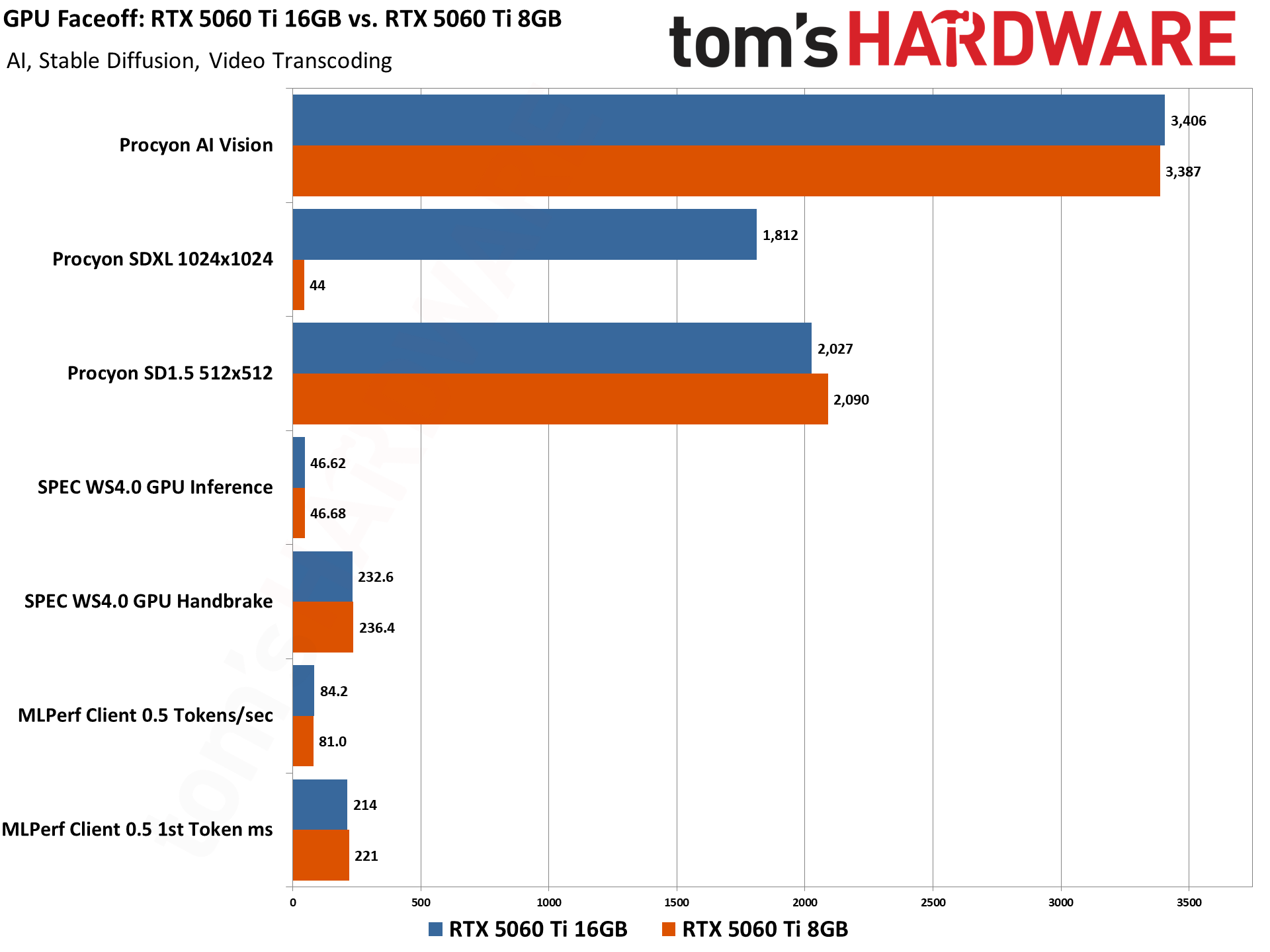
Professional workloads proved to be far less sensitive to VRAM capacity compared to our gaming tests, but problems can still arise. We ran multiple benchmarks in Blender, MLPerf, Spec WS4, and Procyon, and found the RTX 5060 Ti 8GB performed within 1-5% of the 16GB model in most of our benchmark configurations.
The only problematic benchmark on the 8GB RTX 5060 Ti was our Procyon's Stable Diffusion XL 1024x1024 test, which ran the benchmark 97.6% worse than the 5060 Ti 16GB. It goes without saying that if you're running high-resolution AI image generation, you'll need a graphics card with plenty of VRAM.
Besides that main outlier, SPEC WS4's 3dsmax test was the only other benchmark in our suite that showed double-digit performance margins between the two cards. The 8GB card ran this particular test 11.9% slower than the 16GB card.
⭐ Winner: RTX 5060 Ti 16GB
The 8GB variant of the RTX 5060 Ti proved to have sufficient memory to run nearly all of our professional-focused benchmarks, but for the best performance across every possible workload, you'll still want to step up to the 16GB card.
Pricing
Despite having a $50 higher MSRP, the RTX 5060 Ti 16GB provides a better price-to-performance ratio than its 8GB counterpart, even at 1080p. At 1080p ultra, the 16GB provides 7% greater FPS per dollar, 17% greater FPS per dollar at 1440p, and 66% better FPS per dollar at 4K.
Assuming you can find an RTX 5060 Ti 16GB at its $429 MSRP, there's only a $50 difference between that card and the 8GB version. With such a small difference, we'd universally pick the 16GB model for its superior performance, value, and peace of mind.
⭐ Winner: RTX 5060 Ti 16GB
Verdict
| Row 0 - Cell 0 | RTX 5060 Ti 8GB | RTX 5060 Ti 16GB |
Gaming Performance | Row 1 - Cell 1 | ❌ |
Professional workloads | Row 2 - Cell 1 | ❌ |
Pricing | Row 3 - Cell 1 | ❌ |
| Row 4 - Cell 0 | 0 | 3 |
The RTX 5060 Ti 8GB can be a potent graphics card at 1080p, but the limited VRAM capacity does cause problems in games. Not only are higher resolutions and quality settings problematic due to insufficient VRAM, but ray tracing games also take a significant performance hit for the same reason.
8GB of VRAM can also limit gamers' ability to turn on next-gen features that have gotten top billing on Blackwell. We've seen instances where DLSS Multi-Frame Generation fails to work when a GPU is already at the limits of its VRAM pool, and gamers are also sure to be disappointed when they see that this card, while technically RT-ready, can only use that feature in older or lighter RT titles at 1080p without substantially impacting performance.
DLSS upscaling can help reduce VRAM pressure, but you can only crank down its image quality settings so far at 1080p before rough edges start appearing, even with Nvidia's latest DLSS transformer model.
The RTX 5060 Ti 8GB hit fewer speed bumps in our professional workloads, which incorporate many tests that did not run into memory capacity issues. This won't be the case with all professional workloads, especially surrounding AI and large language models, but it is certainly a better situation compared to the gaming side.
In all other areas, the 16GB variant was vastly superior. Even in the pricing department, the 16GB card proved to be a better value as well.
Overall, our testing reveals that 8GB GPUs are no longer as viable as they once were. 8GB is enough to play games at lower resolutions and quality settings, but even at 1080p, 8GB GPUs will struggle to play games maxed out, especially with ray tracing. This will only become more problematic throughout the RTX 5060 Ti 8GB's lifecycle, as games continue to get more and more demanding.
Nvidia is working on neural texture compression, which purports to substantially reduce memory requirements for textures and could reduce VRAM pressure, but there's no telling when that feature will come or how many games will adopt it.
If you are looking for an RTX 5060 Ti, the 16GB version is by far the better version, and possibly the only option depending on your gaming habits.
🏆 Winner: RTX 5060 Ti 16GB

Aaron Klotz is a contributing writer for Tom’s Hardware, covering news related to computer hardware such as CPUs, and graphics cards.
-
A Stoner Looks like 16GB is still valid at 1440P but 8GB will not do it there. This is not a 4k card in the least.Reply -
rc1000 The issue becomes that the basic gaming card is still $400. That's a chunk for a lot of people.Reply -
-Fran- Also, do not forget nVidia is giving you a crippled card on purpose with the 8GB model, evidenced by the simple fact the 16GB performs like a completely different card at more demanding settings without other hardware differences than RAM capacity. This is not even talking about how the extra 8GB is not over $100 difference in terms of BOM.Reply
Same logic for AMD, mind you. The 9600XT 8GB should not exist either. This tier does not need 2 VRAM configs and it just needs the better config.
Both AMD and nVidia could even save* a bit of money on marketing by just doing right by the consumer and get free good will, but alas. Corps be doin' Corpo things.
Regards. -
usertests ReplyDespite having a $130 higher MSRP, the RTX 5060 Ti 16GB provides a better price-to-performance ratio than its 8GB counterpart, even at 1080p. At 1080p ultra, the 16GB provides 7% greater FPS per dollar
Assuming you can find an RTX 5060 Ti 16GB at its $429 MSRP, there's only a $50 difference between that card and the 8GB version.
This math seems fishy.
MSRP: $379 (8 GB), $429 (16 GB)
Street: Newegg is actually throwing a $20 "rebate card" (never heard of that) alongside a $10 promo code, so you could get 8 GB for about $350. 16 GB model can be obtained for $450.
So straight up, it's not a $130 higher MSRP, it's $50 as stated later. The street pricing gap isn't $130 either. I'm not sure where that line came from. Edit: It was probably supposed to be "13%" instead of "$130".
16 GB model is 13% more expensive (MSRP) or about 18-29% more expensive (street). That's 18% if you get the 8 GB for $380, 29% if you get it at $350.
1080p ultra
21 game geomean = +12% avg, +16% lows
15 game raster geomean = +5% avg, 8% lows
6 game raytracing geomean = +37% avg, +44% lows
So with the MSRPs and the 21 game geomean average (with 1080p ultra being a better case for 16 GB than 1080p medium), the 5060 Ti 16 GB's performance is not better than the price difference (+13% money for +12% performance).
Raytracing on the 8 GB model is being dragged down significantly by the Indiana Jones result. It could be argued that's fair, as it indicates that the 8 GB is not enough. It's a small sample size though.
If you are willing to turn down settings (e.g. 1080p medium), the 8 GB card copes better. Performance is being left on the table at higher resolutions, but again, Indiana Jones is dragging it down. For example, 1440p raster average is only 11% higher (however, lows are 21% higher). -
JarredWaltonGPU Reply
I sent Paul/Aaron a note (from the great beyond). I don't know if this was just outdated text based on real-world pricing (at one point the 16GB cards was trending closer to $500 than $430), but these days you can find the 8GB card starting at $370 — $350 if you want to try to get Newegg's mail-in rebate. The 16GB can be had for $430, straight up from Amazon and Newegg with no rebates.usertests said:This math seems fishy.
MSRP: $379 (8 GB), $429 (16 GB)
Street: Newegg is actually throwing a $20 "rebate card" (never heard of that) alongside a $10 promo code, so you could get 8 GB for about $350. 16 GB model can be obtained for $450.
So straight up, it's not a $130 higher MSRP, it's $50 as stated later. The street pricing gap isn't $130 either. I'm not sure where that line came from.
16 GB model is 13% more expensive (MSRP) or about 18-29% more expensive (street). That's 18% if you get the 8 GB for $380, 29% if you get it at $350.
1080p ultra
21 game geomean = +12% avg, +16% lows
15 game raster geomean = +5% avg, 8% lows
6 game raytracing geomean = +37% avg, +44% lows
So with the MSRPs and the 21 game geomean average (with 1080p ultra being a better case for 16 GB than 1080p medium), the 5060 Ti 16 GB's performance is not better than the price difference (+13% money for +12% performance).
Raytracing on the 8 GB model is being dragged down significantly by the Indiana Jones result. It could be argued that's fair, as it indicates that the 8 GB is not enough. It's a small sample size though.
If you are willing to turn down settings (e.g. 1080p medium), the 8 GB card copes better. Performance is being left on the table at higher resolutions, but again, Indiana Jones is dragging it down. For example, 1440p raster average is only 11% higher (however, lows are 21% higher). -
usertests Reply
After reviewing my comment, I think the "$130 higher MSRP" was almost certainly a typo for "13%". 429 / 379 = 1.13192...JarredWaltonGPU said:I sent Paul/Aaron a note (from the great beyond). I don't know if this was just outdated text based on real-world pricing (at one point the 16GB cards was trending closer to $500 than $430), but these days you can find the 8GB card starting at $370 — $350 if you want to try to get Newegg's mail-in rebate. The 16GB can be had for $430, straight up from Amazon and Newegg with no rebates. -
truerock In January I upgraded from an Nvidia GeForce 690 to an Nvidia GeForce RTX 3050 6GB ($180).Reply
I run my PC at 4k, 10bit, 144Hz
I really see no reason to buy a more expensive card.
The only glitch I had in upgrading was that Samsung packed a HDMI 2.0 cable with my
Samsung - Odyssey G7 28” 4K UHD IPS AMD FreeSync Premium Pro & G-Sync Compatible Smart 144Hz 1ms Gaming Monitor
It was causing an occasional 2 to 4 second black screen - maybe 2 or 3 times per day.
When I finally figured out Samsung sent me an HDMI 2.0 cable to use with my HDMI 2.1 monitor - I upgraded the cable and problem solved.
The other thing that took me a while to figure out is that Windows 11 defaults to 150% video scale if you are using a 4k video monitor. That makes things bigger but a little bit fuzzy. I changed the Windows 11 scale to 100% and now I see a lot more (but obviously smaller) but everything is sharper and just as easy to see.
I'm guessing running 4k vs 1080p saves me at least an hour per day of scrolling.
Oh - by the way - I hate Samsung "Smart Screen" - but, so does everyone else. When I bought the monitor in January at BestBuy (ater-Christmas-returns everywhere) - there were huge stacks of "open box" Smart Samsung monitors for sale. So I got a $1,200 monitor for $380. I hate "smart monitors" they are soooo annoying. -
VizzieTheViz The 8GB card is worse for sure, but it could still be a valid choice if you plan on using a 1080p screen and don’t care about raytracing.Reply
If you want 1440p or more AND raytracing then the 16GB card doesn’t deliver playable framerates either, it’s really only good for 1440p without RT or 1080p with RT.
Both are useless for 4K gaming in my opinion.
At least this test shows where more VRAM makes a difference and where it’s pretty much useless so you can make an informed choice, the difference in price is not much but it’s not nothing so why give it to NVidia if you won’t need the extra VRAM anyway. -
Roland Of Gilead I'd agree with @-Fran- .Reply
This craic of having 2 cards in the same tier with different mem/performance is a real pain. It's just not needed.